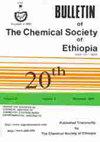氟喹抗生素药物与氯化镧(III)、氯化钐(III)和氯化铽(III)金属药物配合物的制备、光谱和抗癌研究
IF 1.3
4区 化学
Q3 CHEMISTRY, MULTIDISCIPLINARY
引用次数: 0
摘要
合成了[M(FLQ)2(Cl)(H2O)].nH2O 型氟甲喹配体(FLQ)金属配合物,其中 M 为(La(III)、Sm(III)和 Tb(III)),FLQ 为氟甲喹。FLQ 金属配合物可以使用 MCl3 : 氟甲喹以 1:2 的化学计量原位双齿螯合制备。利用元素分析(%C、%H 和%N)、摩尔电导率(Ʌm)、红外光谱(FTIR)、电子能谱(UV-Vis)、热分析(TGA)以及室温下的 X 射线粉末衍射(XRD)、扫描电子显微镜(SEM)和能量色散 X 射线(EDX)测量等物理化学技术,对所获得的 FLQ 复合物进行了表征。因此,这些配合物显示出八面体配位结构。氟甲喹配体通过羰基(喹啉酮)和羧基的氧原子以双齿方式配位。研究结果表明,这些化合物对 HepG-2 和 MCF-7 癌细胞株具有抗癌功效,剂量极低,可达 58.2 毫克/毫升。与钐和铽(III)复合物相比,La(III)复合物对癌细胞的选择性最高。关键字:氟甲喹,镧系金属离子,傅立叶变换红外光谱,电子衍射X,络合,抗癌活性 Bull.Chem.Soc.2024, 38(3), 671-684. DOI: https://dx.doi.org/10.4314/bcse.v38i3.10本文章由计算机程序翻译,如有差异,请以英文原文为准。
Preparation, spectroscopic and anticancer investigations of metal-drug complexes associated between flumequine antibiotic drug with lanthanum(III), samarium(III) and terbium(III) chloride
Flumequine ligand (FLQ) metal complexes of the [M(FLQ)2(Cl)(H2O)].nH2O type, where M are (La(III), Sm(III), and Tb(III)) and FLQ is flumequine have been synthesized. The FLQ metal complexes could be prepared using MCl3 : flumequine in stoichiometry of 1:2 in situ bidentate chelation. The characterization of FLQ complexes obtained have been done using elemental analyses (%C, %H and %N), molar conductivity (Ʌm), infrared spectroscopy (FTIR), electronic spectra (UV-Vis), thermal analysis (TGA), and physicochemical techniques such as X-ray powder diffraction (XRD), scanning electron microscopy (SEM), and energy dispersive X-ray (EDX) measurements at room temperature. Accordingly, these complexes are indicative of an octahedral coordination structure. Flumequine ligand has a bidentate fashion through the oxygen atoms of carbonyl (quinolone) and carboxylic groups. The findings demonstrated the anti-cancer efficacy of these compounds against HepG-2 and MCF-7 cancer cell lines at extremely low doses of up to 58.2 mg/mL. The La(III) complex was shown to have the highest selectivity against cancer cells in comparable with both samarium and terbium(III) complexes.
KEY WORDS: Flumequine, Lanthanide metal ions, FTIR, EDX, Complexation, Anticancer activity
Bull. Chem. Soc. Ethiop. 2024, 38(3), 671-684.
DOI: https://dx.doi.org/10.4314/bcse.v38i3.10
求助全文
通过发布文献求助,成功后即可免费获取论文全文。
去求助
来源期刊
CiteScore
2.20
自引率
8.30%
发文量
113
审稿时长
6-12 weeks
期刊介绍:
The Bulletin of the Chemical Society of Ethiopia (BCSE) is a triannual publication of the Chemical Society of Ethiopia. The BCSE is an open access and peer reviewed journal. The BCSE invites contributions in any field of basic and applied chemistry.

 求助内容:
求助内容: 应助结果提醒方式:
应助结果提醒方式:


